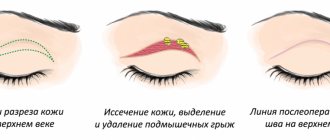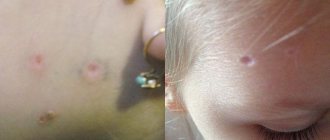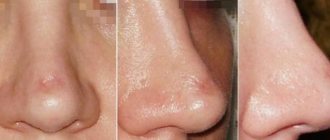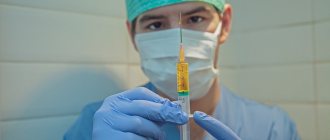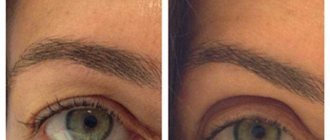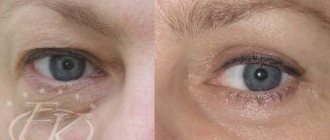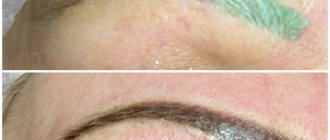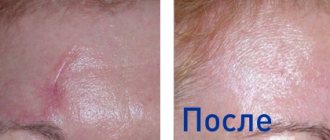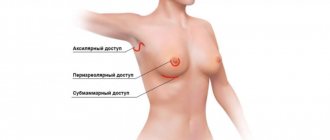In everyday life, our skin courageously performs its protective function, saving us in thousands of cases, but sometimes its restorative reserve is not enough, and areas replaced by connective tissue appear on our body or face, what we know as a scar, scar, stretch mark...
For a long time, it was firmly believed that dealing with scars and scars was a thankless task. “It is what it is” or “there’s nothing to be done about it” and other phrases that make your eyes glaze over and resign yourself, calm yourself with the thought that over the years all scars fade, almost merge with the color of the skin and you shouldn’t concentrate so much on it. But the inevitable pursuit of perfection does not allow us to stop and just wait.
The problem of scar correction is common for both surgeons and dermatocosmetologists. To achieve the maximum therapeutic effect, it is very important to identify the stages of scarring and select procedures for targeted scar correction based on the “status of limitations” of the formed scar tissue.
In this article, we wanted to review modern methods for correcting already formed scars, regardless of their origin (trauma, burn, post-acne or postoperative scar) at different stages of scarring.
If the damage affects only the epidermis, then practically no traces remain, since the cells of the basal layer of the epidermis retain the ability to fully regenerate throughout life. If the damage affects the deeper layers of the skin (dermis), then the tissue defect is filled with granulation tissue, which subsequently forms into a scar . During the normal course of the scarring process, the scar tissue gradually flattens and acquires the color of the surrounding tissues (normotrophic scar). If the course of the process is disrupted, then there is a high probability of the formation of pathological scars.
Stages of scar formation
In its formation, the scar goes through 4 successive stages :
I - stage of inflammation and epithelization
It takes from 7 to 10 days from the moment the injury occurs. Characterized by a gradual decrease in swelling and inflammation of the skin. Granulation tissue is formed, bringing the edges of the wound closer together; there is no scar yet. If infection or divergence of the wound surface does not occur, the wound heals by primary intention with the formation of a barely noticeable thin scar. In order to prevent complications at this stage, atraumatic sutures are applied that spare tissue, and daily dressings are performed with local antiseptics. Physical activity is limited to avoid divergence of wound edges.
II - stage of formation of a “young” scar
Covers the period from the 10th to the 30th day from the moment of injury. It is characterized by the formation of collagen-elastin fibers in granulation tissue. The scar is immature, loose, easily extensible, bright pink in color (due to increased blood supply to the wound). At this stage, secondary wound trauma and increased physical activity should be avoided.
III - stage of formation of a “mature” scar
Lasts from the 30th to the 90th day from the date of injury. Elastin and collagen fibers grow into bundles and line up in a certain direction. The blood supply to the scar decreases, causing it to thicken and turn pale. At this stage there are no restrictions on physical activity, but repeated trauma to the wound can cause the formation of a hypertrophic or keloid scar.
IV - stage of final scar transformation
Starting from 4 months after injury and up to a year, the final maturation of the scar occurs: the death of blood vessels, tension of collagen fibers. The scar thickens and turns pale.
The histological classification of physiological scarring includes three stages and gives the doctor additional information about the condition of the scar tissue at different periods:
- Stage 1 - fibroblastic - lasts up to 30 days, it is characterized by the appearance of young fibroblasts and an abundance of blood vessels.
- Stage 2 - fibrous - is formed by the 33rd day from the moment of injury; characterized by the presence of mature fibroblasts and the accumulation of fibrous structures in the scar tissue, primarily collagen fibers.
- Stage 3 - hyaline - is formed by the 42nd day; characterized by a decrease in the number of cells and vessels.
By studying the stages of scarring, a thorough diagnosis can be made and an effective treatment plan can be developed.
How to get rid of old scars using cosmetology
The beauty industry has a much wider choice of ways to treat old scars: peeling, dermabrasion, cryodestruction, etc.
- Cryodestruction. Treatment with liquid nitrogen involves exposing rumen cells to cold (temperature -190 degrees Celsius). Nitrogen penetrates so deeply that oxygen can no longer enter the rumen membranes and they collapse. This is how a zone of necrosis appears around the skin defect - within a month, tissue macrophages destroy the connective tissue and the scar disappears.
- Beech therapy. Ultra-soft x-rays penetrate the epidermal tissue, where they stimulate cells to regenerate and restore impaired metabolism.
- Peeling. It can be hardware, mechanical and chemical. During the procedure, the top layer of the epidermis, consisting of dead cells, is cut off. In this case, there is a feeling of discomfort and pain.
- Microdermabrasion. Like peeling, the principle of operation is to cut off the top layer of skin. However, the procedure does not cause pain due to smaller crystal particles (usually aluminum oxide) that are used to polish the skin.
- Laser resurfacing. All the same cutting down of the stratum corneum of the epidermis, but with the help of a laser. Some devices have a built-in cooling attachment to prevent pain during the procedure. At the client's request, the cosmetologist applies an anesthetic solution.
Each type of the listed procedures involves a rehabilitation period, during which you will have to endure unpleasant restrictions in everyday life: this may be the need to refuse visits to the solarium, stay away from the bright sun, not use cosmetics, etc. The problem will not be solved in one session - you will have to take the entire course, which is not very budget-friendly. Before visiting a cosmetologist, it is recommended to consult a doctor about your individual case and the presence of serious contraindications.
Types of scars
It is very important to correctly determine the type of scar to determine the duration and choice of treatment method. The following types of scars are distinguished:
Normotrophic scars
Normotrophic scars are flush with the surrounding skin, pale or flesh-colored, and have an elasticity similar to that of normal tissue. They most often do not bother the patient. As a rule, it is not recommended to treat them radically, that is, resort to surgery. But this does not mean that they should not be dealt with. Here, superficial (sometimes medium) chemical peels come to the doctor’s aid. With timely treatment, normotrophic scars can be made almost invisible.
Atrophic scars
Atrophic scars - often such scars are called “minus tissue”, due to the fact that they are located below the level of the surrounding skin. Such scars, which usually remain after acne or chickenpox, are formed as a result of insufficient formation of connective tissue. One example of atrophic scars is also stretch marks (stretch marks).
Hypertrophic and keloid scars
Hypertrophic and keloid scars, on the contrary, are redundant. Their formation is associated with excessively intense work of the cellular matrix. Such scars are formed at the site where the integrity of the skin is damaged: due to wounds, burns, surgical interventions, ear piercing or tattoos. Hypertrophic scars protrude above the surface of the skin, are limited to the injured area and spontaneously regress within two years, although the regression may be incomplete. The best cosmetic result is achieved with surgical treatment - excision of scar tissue and then this scar is treated by dermatocosmetologists as normotrophic. If the scar is small, then treatment with chemical peels works well. In recent years, fractional photothermolysis has become increasingly popular in the elimination of both atrophic and normotrophic scars.
Keloid scars
Keloid scars appear as a result of individual pathological changes in the structure of scar tissue. Keloid scars can have different shapes and sizes, often not matching the lines of the surgical incision or injury. Such scars cause a lot of trouble. They begin as a small nodular lump, then quickly grow and increase in size, maintaining a tendency to grow for many years. The formation and growth of a keloid is accompanied by itching, pain, burning and tissue tension. The surface of the keloid scar is sharply demarcated from healthy skin. The scar itself is convex, shiny, and has a purple or bluish color. In the case of keloid scars, the treatment process is long, requiring careful selection of the correction method. It makes sense to consider the tactics of managing keloid scars separately.
Successful correction can only be guaranteed by the most accurate diagnosis of the type of scar, with analysis of medical history, selection of an adequate correction method and competent and thorough home care. It is always easier to achieve a pronounced result when correcting fresh scars (existing up to 1 year).
Having decided what type of scar it is, what stage of chronological and histological development it is at, we can select the optimal treatment program .
Let's talk in more detail about correction methods.
Scars after abdominoplasty
Patients who contact the plastic surgery center to correct the shape and relief of the abdomen are interested not only in the removal of excess fat, but also in the aesthetics of a new look. For women, it is important that there are as few scars as possible, and those that cannot be avoided are invisible. No plastic surgeon can predict how the body will react to surgery. The type of scars, their size, and shape depend on the individual characteristics of the body, race, gender, age, genetics, the functioning of the immune system, and the technique chosen for plastic surgery.
What affects scar formation after abdominoplasty?
The body's response to damage to the epidermis is the formation of scar tissue at the site of the incision. The most modern techniques for abdominal operations do not guarantee that the trace of the surgeon’s work will be invisible. Injuries caused by a scalpel during tummy tuck trigger inflammatory reactions, causing the body to produce collagen at the incision site in order to quickly close the damaged area with a reliable scar. In this case, a dense, red, clearly visible mark is formed at the site of the incision, looking like a small roller, slightly rising above the skin.
The body strives to close the incision as quickly as possible, to eliminate a potentially dangerous source of infection. Massive collagen production gradually stops as the edges of the wound begin to heal, stopping completely once the edges of the skin at the incision site have completely fused. After which a normal internal scar is formed. Effective postoperative therapy, strict adherence to the doctor’s instructions, and constant wound care make it possible to give the scars a normal appearance that does not spoil the appearance.
Stages of scar formation
Information about the scarring processes at the incision sites made by a plastic surgeon will help you understand what your body will look like after abdominoplasty.
- The first phase begins immediately after surgery. Lasts 5-7 days. The body seeks to protect the inflamed area by forming a mass of granulation cells. It is this period that most clearly highlights the site of the operation. Burgundy, red marks appear at the site of the incisions.
- The onset of proliferation during the second stage, which lasts about a month, ensures the formation of a new capillary network and the disappearance of swelling and redness.
- The third stage lasts six months. During this time, the fish gradually lighten, acquiring shades characteristic of the usual skin color range. The height of the scars decreases.
- A year after entering the final stage, scars acquire the color of the adjacent skin and become flat.
On a note!
By strictly following the rules prescribed by the attending physician, the patient speeds up the regeneration process, which allows him to quickly get rid of unsightly scars.
The Four Main Types of Scars After Abdominoplasty
Tummy tuck surgery is very popular, despite the fact that unsightly scars appear after the operation. The surgeon removes more than half the volume of skin located between the lower ribs and the groin. To improve aesthetics, the specialist strives to do everything possible to ensure that the result of the surgical intervention is invisible.
- Normotrophic. The ideal result of collaboration between the doctor and the patient, who accurately followed the plastic surgeon’s instructions when restoring the body. The scar is almost invisible. A flat scar that fully matches the color of the natural epithelium is noticeable only at close range.
- Atrophic. During recovery, the body produced little collagen for some reason. The result is tissue retraction inward. Formation of a clearly visible groove at the incision site.
- Hypertrophic. With poor care, non-compliance with the procedures prescribed by the attending physician, pronounced inflammatory processes, and strong tension on the edges of the wound, the scars grow excessively, rising greatly above the skin. Bright pink, burgundy shades, uneven edges indicate the need for additional treatment, new surgical intervention.
- Keloid. The most negative development of events after surgery. It doesn't look nice. Continuously growing. The fight is greatly complicated by the desire to absorb adjacent areas of the skin. Most often this is the result of genetic abnormalities. Therefore, a number of special studies are carried out before the operation.
Important!
Complete removal of the scar is impossible. The correct technique, clearly performed tummy tuck, strict adherence to the rules of rehabilitation will make the scar thin and invisible.
Techniques to reduce the risk of unsightly scars after abdominoplasty
You can minimize the consequences of tummy tuck for the aesthetics of your appearance by strictly adhering to simple rules.
- Constantly wearing compression garments during the first month will reduce the risk of severe scarring of the sutures. The texture of the fabric creates a light massage effect, accelerating the disappearance of swelling, while improving blood circulation.
- The use of fibrinolytic, keratolytic, antithrombotic, anti-inflammatory gels accelerates tissue regeneration, reducing the risk of developing inflammatory processes, helping to avoid the formation of excess tissue at the incision site.
- Using silicone tapes, the patient does not allow the scars to stretch or become rough, maintaining an optimal state of suture tension until the epidermis is completely healed.
- Maximum rest during the first month to minimize the risk of injury from tissue stretching.
On a note!
Scars after abdominoplasty will become less noticeable if you strictly follow all the doctor’s instructions. After complete tissue regeneration, you can use the services of beauty salons.
Repairing broken seams
You cannot completely protect yourself from the danger of suture dehiscence after tummy tuck. Despite the fact that the specialists of the plastic surgery center have solid practical experience, a problem may arise due to an error in the choice of suture materials, individual characteristics of the body, excessive activity of the patient after surgery, or physiological complications.
- Do not stop treating the edges of the wound until it is completely healed, until the plastic surgeon instructs you to stop the procedures.
- Applying additional tape to the incision site will minimize the risk of tissue tension.
- Do not get the seam area wet. Completely eliminate the possibility of any dirt getting on the scar.
- Do not remove compression garments until your attending physician allows you to do so.
- Make sure that the abdominal muscles are not overstrained. Reduce loads as much as possible.
If you notice even minor changes that indicate a deterioration in your health, consult a doctor immediately. Quickly taking the necessary measures will eliminate negative consequences.
Treatment of scars after abdominoplasty
Modern medicine has a solid arsenal of tools that allow you to quickly and effectively get rid of unsightly scars.
- The help of a surgeon to remove scars will be required after the body has fully recovered after tummy tuck. An experienced plastic surgeon will remove excess scar tissue, ideally connect the edges of the incision, and apply cosmetic sutures. Additional procedures will increase the effectiveness of the operation.
- Cosmetic procedures are possible no earlier than a year after the body has fully recovered. The doctor selects procedures based on the objective condition of the body. If the scar color is bright, fractional laser therapy will help seal the capillary walls, making the color of the scar more muted. The maximum effect can be achieved after 4-8 sessions. Peels or lasers smooth out the excess bulge of the scar. The procedures are painful and have a number of contraindications, so a preliminary consultation is necessary.
- Injections of diprospan or kenalog are done on an outpatient basis until the normal color and condition of the scar are completely restored, and the development of inflammatory processes ceases. The procedure does not require additional anesthesia, and the patient does not experience any discomfort. Conservative treatment gives excellent results if you consult a doctor in a timely manner.
- You can use silicone patches or tapes without a doctor’s prescription after 2-3 weeks of rehabilitation. Gentle pressure on the scar helps smooth out the surface, giving it a more attractive appearance. The porous structure of the patch ensures free air flow, which reduces the risk of irritation. Silicone maintains the necessary humidity, preventing the epidermis from drying out. Mepiform, Dermatix, Kelokote and other manufacturers produce a wide range of silicone tapes and patches. The benefits of using silicone tapes or patches range from 70-80 percent. The optimal benefit from them is if they are used in combination with other means that affect the rapid elimination of postoperative scars.
- Scar ointments should be used as prescribed by your doctor. As an example, you can use fermenkol, which contains 9 active enzymes. The manufacturer offers tubes with a transparent gel that has a cooling effect for local application or a solution for a course of electrophoresis. The drug regulates the amount of collagen produced without affecting healthy tissue in any way. Excess collagen fibers are broken down by the drug into simple elements. A healthy epidermis is formed from new components or is excreted from the body in the usual way. The attending physician will explain in detail how to apply ointments for scars in order to quickly achieve the desired result.
- Cryotherapy has long been used in cosmetology to quickly eliminate scars. The scheme of exposure to tissue is selected individually after examination by a specialist. It is best when therapy is carried out comprehensively, combining injections, electrophoresis, and ointments. The final result is always individual and depends on how effectively the body responds to the procedures performed.
- Physiotherapy is possible at home, for which it is enough to purchase the necessary equipment. Under the influence of weak currents, the applied drug quickly penetrates deep into the epidermis. Phonophoresis or electrophoresis are the most common procedures that guarantee excellent results. The procedure takes 10-15 minutes, ensuring rapid penetration of drugs into the deep layers of tissue. There is no discomfort, the first result will appear after one session.
Important!
The doctor selects an individual method of dealing with scars for each patient, since the body’s reaction is always different.
Additional ways to deal with scars after abdominoplasty
The type and number of scars after tummy tuck is different for each person. The younger the patient, the faster the recovery. To ensure that the scar becomes inconspicuous as quickly as possible after final rehabilitation, you can use several publicly available methods to eliminate the consequences of a plastic surgeon’s work.
- CO2 laser is a reliable tool that can cope with any scars. This is a kind of heavy artillery on the battlefield for its beautiful appearance. The equipment virtually vaporizes the scar by breaking the hydrogen bonds in the scar. Thermal effect on a small area triggers regenerative processes in this place, due to which a new epidermis is formed at the site of the incision instead of connective tissue. However, you should not expect that the scar will disappear without a trace. It will be much thinner and its color will become indistinguishable from the skin. It will be necessary to apply special creams or gels to the laser site to eliminate the risk of infection or hyperpigmentation.
- Plasmolifting is good for quickly smoothing out scars larger than plastic surgery. The procedure is not suitable if there are more rough scars. Microinjections of plasma obtained from the patient’s blood trigger regeneration processes, accelerating the creation of new elastin networks.
- A beautiful tattoo is not medical, but it is a completely acceptable way to disguise scars. If all technical medical means have been used, but the scar cannot be removed, the seam is covered with a beautiful pattern. An ornate abstract pattern is selected that looks perfect on the body. You can contact a tattoo artist only after all post-operative changes have been completed.
When planning to have an abdominoplasty, be mentally prepared for the fact that the recovery process will require some effort and strict adherence to all the recommendations of the attending physician. Only the joint work of the plastic surgeon and the patient can cope with this difficult task.
Scar correction: a review of methods
Surgical excision of scars
Surgical correction of scars allows you to replace existing scars with more accurate and less noticeable ones. Often, the surgical method of scar correction - excision of the scar with or without plastic surgery using local tissues - is the only way to improve the appearance of the scar, especially when it comes to reducing the width of the scar.
Surgical excision of scars contributes to:
- reducing the width of the scar;
- correction of tissue relief disorders in the scar area;
- removing foreign particles from scar tissue (if any);
- moving the scar to a hidden area.
Surgical correction of scars involves the use of local infiltration anesthesia (1% lidocaine solution, 0.25%, 0.5% novocaine solution), or endotracheal anesthesia. The scar is excised with a scalpel or laser (laser scar correction). Mobilization (lifting) of the wound edges is performed, with simultaneous coagulation of blood vessels. The last stage of surgical excision of scars is suturing.
In scar removal, the postoperative period is very important, in which a number of key points are highlighted. After surgical removal of the scars has been performed, a pressure bandage is applied to the wound, which helps stop bleeding. It is applied for a day. After surgery, you should avoid exposure to sunlight as long as possible, as well as injury and tension in the scar area.
One of the complications is the discrepancy between the outcome of the operation and the patient’s expectations. But if the operation is performed correctly, the patient is adequate, informed and has realistic expectations, he will almost always be satisfied.
In the first days after surgery, there may be a slight rise in temperature. If the temperature rises to high levels, severe swelling occurs, or intense pain appears in the wound area, you should immediately contact the clinic; this may be inflammation. Although surgical excision of scars rarely causes inflammation, antibiotics are always prescribed as a preventive measure.
Surgical correction is the option of choice for extensive hypertrophic scars. It is very important to differentiate from keloid scars before excision.
Chemical peels
Chemical peels are a very successful tool for working with scars in the early stages of their formation. Superficial and medium peels have proven themselves to be the best for working with scars and stretch marks.
The course of superficial chemical peels for atrophic and hypertrophic scars can be divided into two stages:
- Preparatory stage At the first stage, superficial chemical peels are used with a frequency of once every six to seven days, two to four superficial peeling procedures are performed (glycolic, salicylic, lactic and pyruvic acids are used).
- Stage of stimulation of natural reparative (restorative) processes At this stage, five to ten procedures are carried out, increasing the acid exposure time - to stimulate natural physiological processes, reorganize the capillaries of the dermis and collagen fibers. In addition, peeling has a defibrosing effect, improving trophic processes in surrounding healthy tissues.
Removing stitches
Posted at 19:38h in Services by doctor
Any surgical intervention brings a certain amount of stress to the human body. The doctor’s task in such a difficult period for the patient is not only to perform the operation competently and professionally, but also to prepare the patient for the recovery process.
Almost no surgical operation is complete without sutures, which are a way to connect biological tissues and help reduce bleeding and bile leakage.
